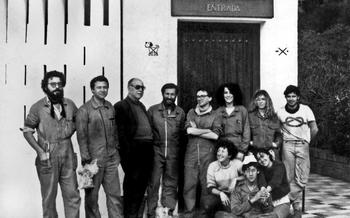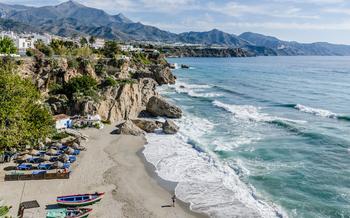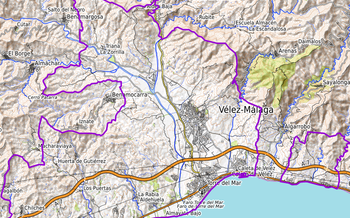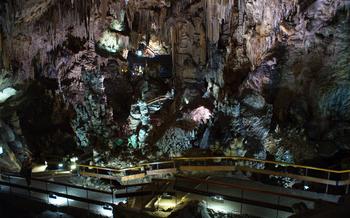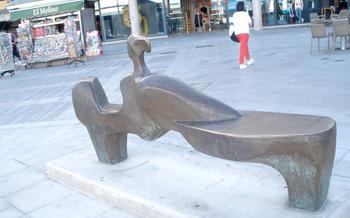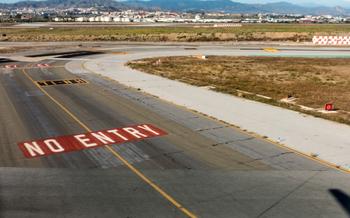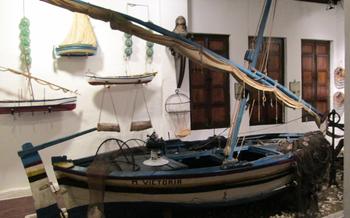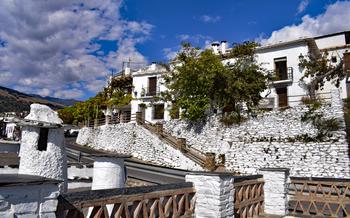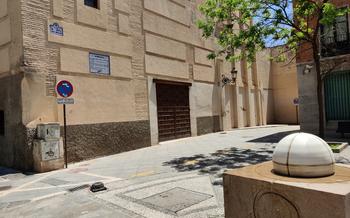
Nerja Caves (nearby)
- Nerja Caves: A Hidden Gem in Andalusia
- Location and Accessibility
- History and Discovery
- The Cave System
- Prehistoric Art
- Flora and Fauna
- Guided Tours
- Visitor Facilities
- Tips for Visitors
- Nearby Attractions
- Planning Your Visit
- Photography and Videography
- Sustainability and Conservation
- Accessibility for Visitors with Disabilities
- Insider Tip: Secret Spots
Nerja Caves: A Hidden Gem in Andalusia
Hidden beneath the sun-drenched hills of Andalusia, in the southern region of Spain, lies an enchanting subterranean world, waiting to be explored. The Nerja Caves are a natural and historical treasure trove that offers a glimpse into the region's rich past and its captivating natural beauty. A visit to these caves is a journey through time and art, where stunning geological formations intertwine with ancient human history and artistic expressions, leaving every visitor in awe.
Geological Formation: The Nerja Caves are a product of millions of years of erosion and dissolution of the surrounding limestone rock by underground water. This process, known as karstification, has resulted in an intricate network of chambers, galleries, and stalactites and stalagmites that adorn the cave walls and ceilings. The result is a mesmerizing display of natural artistry that has captivated visitors for centuries.
Archaeological Significance: The Nerja Caves hold significant archaeological importance as they have revealed evidence of human habitation dating back to the Upper Paleolithic era. The discovery of cave paintings, engravings, and other artifacts has shed light on the lives and cultural practices of our ancestors who once called these caves their home.
Artistic Representations: The Nerja Caves are home to a remarkable collection of cave paintings and engravings that depict a variety of subjects, including animals, human figures, and abstract symbols. These artistic representations offer valuable insights into the beliefs and imagination of the early inhabitants of the caves.
Guided Tours: To fully appreciate the wonders of the Nerja Caves, guided tours are available to provide visitors with a comprehensive insight into the cave's geological, archaeological, and artistic significance. These tours are led by knowledgeable guides who share fascinating stories and explanations, enhancing the overall experience for visitors.
Location and Accessibility
The Nerja Caves are conveniently situated just 50 kilometers east of Granada, making them an ideal day trip destination. The caves are easily accessible by car, with well-marked road signs guiding visitors along the scenic route. For those without their own transportation, there are regular bus services that connect Granada to Nerja, and taxis are readily available.
Upon reaching Nerja, follow the signs for the caves, which are located on the eastern outskirts of town. Ample parking is available at the cave entrance, ensuring a hassle-free visit for drivers. Whether you choose to drive or take public transportation, the Nerja Caves are within easy reach, inviting you to delve into their subterranean wonders.
History and Discovery
The Nerja Caves have been known to local people for centuries, but their significance was only fully realized in the mid-20th century. In 1959, a group of local boys stumbled upon a hidden chamber while exploring the caves. Inside, they discovered a wealth of prehistoric paintings and engravings, revealing the artistic and cultural importance of the site.
Subsequent archaeological excavations uncovered evidence of human occupation dating back to the Paleolithic era, around 40,000 years ago. The caves were likely used as a shelter and hunting ground by early humans, who left behind a rich legacy of cave art. The discovery of these ancient remains has shed new light on the lives and beliefs of our ancestors.
In 1960, the Nerja Caves were declared a National Monument of Spain, recognizing their historical and cultural significance. In 1999, UNESCO designated the caves as a World Heritage Site, further cementing their status as a global treasure. Today, the caves are open to the public, allowing visitors to explore their depths and marvel at the wonders they hold.
The Cave System
The Nerja Caves are an extensive network of underground chambers and galleries, stretching for over 4 kilometers. The layout of the caves is complex, with different levels and interconnected passages. Visitors can explore several chambers, each with its unique geological formations and characteristics.
One of the highlights of the cave system is the Sala del Ballet, a vast chamber named after the ballet-like formations of stalactites and stalagmites that resemble dancers frozen in motion. Another notable chamber is the Sala de la Cascada, featuring a waterfall-like formation that cascades down the cave walls.
The caves are renowned for their impressive stalactites and stalagmites, which have been formed over thousands of years by the dripping of mineral-rich water. These formations take on various shapes and sizes, creating a surreal and enchanting landscape. The caves also feature unique geological formations such as flowstones, curtains, and helictites, adding to the diversity and beauty of the cave system.
The acoustics of the Nerja Caves are exceptional, making it a popular venue for concerts and performances. The natural reverberation and resonance of the caves create an immersive and unforgettable auditory experience.
Prehistoric Art
The Nerja Caves are a treasure trove of prehistoric art, boasting a remarkable collection of cave paintings and engravings that offer a glimpse into the lives and beliefs of our ancestors. These artistic expressions, created using a variety of techniques and styles, range from simple geometric patterns to intricate depictions of animals, human figures, and symbolic motifs.
The paintings, executed in vibrant shades of red, yellow, and black, showcase the remarkable artistic skills of the prehistoric inhabitants. The engravings, meticulously carved into the cave walls, reveal a deep connection to the natural world and a rich symbolic language. Some of the most notable motifs include horses, goats, deer, and enigmatic human-like figures, often arranged in dynamic compositions that tell stories of hunting, rituals, and everyday life.
The symbolism embedded in these artworks remains a subject of ongoing study, with interpretations ranging from depictions of hunting scenes and fertility rituals to representations of the cosmos and spiritual beliefs. The Nerja Caves provide a unique opportunity to explore the artistic expression of prehistoric humans and gain insights into their cultural and spiritual world.
Flora and Fauna
The Nerja Caves are home to a fascinating and unique ecosystem that has adapted to the cave's dark, humid, and constantly cool conditions. Despite the lack of sunlight, several plant and animal species have found refuge and sustenance within the cave's chambers and galleries.
The cave walls and ceilings are adorned with a variety of ferns, mosses, and liverworts that thrive in the humid environment. These plants play a vital role in the cave's ecosystem, providing food and shelter for various cave-dwelling creatures.
The fauna of the Nerja Caves is equally diverse and includes several endemic and endangered species. One of the most notable inhabitants is the Andalucían cave salamander, a small amphibian that is unique to the caves and the surrounding area.
Bats are another common sight in the Nerja Caves. Several species of bats, including the greater horseshoe bat and the Mediterranean horseshoe bat, roost in the caves, utilizing the dark crevices and chambers for shelter and breeding.
The cave environment also supports a variety of invertebrates, such as spiders, beetles, and millipedes. These creatures play a crucial role in the cave's ecosystem by breaking down organic matter and contributing to nutrient cycling.
Conservation efforts are underway to protect the unique flora and fauna of the Nerja Caves. These efforts include monitoring and regulating cave access, conducting scientific research, and educating visitors about the importance of preserving the cave's delicate ecosystem.
Guided Tours
To fully appreciate the wonders of the Nerja Caves, it is highly recommended to embark on a guided tour. Conducted by knowledgeable and passionate guides, these tours provide an immersive experience that unravels the fascinating history, geology, and artistic significance of the caves. Tours are available in various languages, catering to international visitors, and run at regular intervals throughout the day.
Group sizes are kept small to ensure a personalized experience and to minimize impact on the delicate cave environment. During the tour, guides illuminate the intricate details of the cave formations, explain the scientific discoveries made within the caves, and share anecdotes and insights that bring the caves' story to life.
Guided tours typically last for about 45 minutes to an hour, allowing ample time to explore the most remarkable chambers and galleries. Visitors can choose from different tour options based on their interests and time constraints. Standard tours cover the main highlights of the caves, while more comprehensive tours delve deeper into the cave system, showcasing additional chambers and providing in-depth explanations.
The cost of guided tours varies depending on the tour type and the time of year. Advance reservations are highly recommended, especially during peak tourist season, to secure a spot and avoid disappointment.
Visitor Facilities
The Nerja Caves offer a range of facilities to enhance the visitor experience. Upon arrival, visitors are welcomed at the visitor center, where they can obtain information about the history, geology, and significance of the caves. Here, you can also purchase tickets for guided tours and browse souvenirs at the gift shop.
After purchasing tickets, visitors can proceed to the caves, where they will be led by an experienced guide. Tours are available in multiple languages, ensuring that international travelers can fully appreciate the wonders of the caves.
For those who prefer a bite to eat or a refreshing drink, there is a cafeteria located within the caves. Here, you can indulge in a variety of snacks, sandwiches, and beverages, providing a convenient option for refueling during your exploration.
Overall, the visitor facilities at the Nerja Caves aim to provide a comfortable and informative experience for all visitors, ensuring that they have a memorable and enjoyable time exploring this natural wonder.
Tips for Visitors
To ensure a smooth and enjoyable visit to the Nerja Caves, here are some practical tips for visitors:
-
Advance Reservations Recommended: Given the popularity of the caves, it's highly recommended to make reservations in advance, especially during peak tourist seasons. Online booking options are available on the official website or through reputable tour operators.
-
Comfortable Footwear and Clothing: The cave exploration involves walking on uneven surfaces and climbing stairs, so comfortable footwear with good traction is essential. Dress in layers as the temperature inside the caves can be cool and humid.
-
Flash Photography Prohibited: To preserve the delicate cave paintings and formations, flash photography is strictly prohibited inside the caves. Visitors are encouraged to use natural light or low-light settings on their cameras.
-
Respect for the Cave Environment: The Nerja Caves are a fragile and unique ecosystem, and visitors are expected to respect the environment by refraining from touching the cave walls or formations, and by avoiding littering or causing any damage.
Nearby Attractions
The Nerja Caves are situated in a region brimming with captivating destinations that warrant exploration. The town of Nerja itself boasts stunning beaches, inviting visitors to bask in the sun and indulge in refreshing swims. Just a short drive away lies the charming village of Frigiliana, where the legacy of Moorish rule is evident in its architecture and cultural heritage. Embrace the natural wonders of the Maro-Cerro Gordo Cliffs Natural Park, where breathtaking cliffs meet the azure waters of the Mediterranean Sea. For a vibrant urban experience, venture to the city of Malaga, renowned for its rich history, vibrant arts scene, and mouthwatering cuisine. With so much to discover in the vicinity, your journey through this region promises to be an unforgettable adventure.
Planning Your Visit
The Nerja Caves offer a unique and unforgettable experience, but planning your visit carefully will ensure you make the most of it.
The best time to visit is during the shoulder seasons (April-May and September-October) when the weather is pleasant, and the crowds are smaller. However, the caves are open all year round, so you can visit them whenever it suits your schedule.
If you're short on time, you can easily combine a visit to the caves with other activities in the region. For example, you could spend the morning exploring the caves and then head to the nearby town of Frigiliana for a delicious lunch and a stroll through its charming streets.
Alternatively, you could spend a few days in Nerja, enjoying its beaches, bars, and restaurants, and taking a day trip to the caves.
There are several accommodation options in Nerja to suit all budgets and preferences. If you're on a tight budget, there are several hostels and guesthouses to choose from. If you're looking for a more luxurious experience, there are also several hotels and resorts to choose from.
Photography and Videography
Capturing the breathtaking beauty of the Nerja Caves through photography and videography is an unforgettable experience. However, it's important to adhere to certain regulations to ensure the preservation of the cave environment and respect for other visitors.
Tripod Use: The use of tripods is generally allowed within the caves, but it's essential to set them up in a way that doesn't obstruct the paths or interfere with other visitors' enjoyment. Please be mindful of your surroundings and choose spots that won't cause inconvenience to others.
Special Permits: If you're planning to take photographs or videos for commercial purposes, you'll need to obtain a special permit from the cave authorities. This is to ensure that the cave's unique features are appropriately represented and protected.
Capturing the Cave's Beauty: To capture the true essence of the Nerja Caves, consider using a wide-angle lens to encompass the vastness of the chambers and formations. Experiment with different lighting techniques to highlight the intricate details and textures of the cave walls. Remember to adjust your camera settings to minimize noise and ensure sharp, clear images.
Sharing Your Experiences: Once you've captured the magic of the Nerja Caves, don't hesitate to share your experiences with the world. Post your stunning photos and videos on social media, using relevant hashtags to connect with fellow travelers and photography enthusiasts. Your images can inspire others to explore the wonders of this hidden gem in Andalusia.
Sustainability and Conservation
The Nerja Caves are a remarkable natural heritage that requires careful preservation and responsible tourism practices. Visitors should prioritize minimizing their environmental impact by adhering to designated pathways, refraining from touching or disturbing the cave formations, and avoiding the use of flash photography. Supporting local conservation efforts is crucial, as organizations dedicated to protecting and maintaining the caves rely on donations and responsible tourism practices. Educational programs and initiatives offered by local authorities and conservation groups raise awareness about the significance of the caves and promote responsible tourism practices. By embracing sustainable tourism, visitors contribute to the long-term preservation of the Nerja Caves for future generations to enjoy.
Accessibility for Visitors with Disabilities
The Nerja Caves are committed to providing an accessible and enjoyable experience for visitors with disabilities. Wheelchair users can explore the caves via a designated accessible route that allows them to navigate the cave system without difficulty. The cave's staff is trained to assist visitors with disabilities and ensure their safety and comfort throughout their visit.
In addition, special guided tours are available for visually impaired visitors. These tours utilize audio guides and descriptive signage to provide a comprehensive and immersive experience for those who are unable to see the cave's wonders firsthand. Assisted listening devices are also available for those with hearing impairments.
The cave's visitor center is fully accessible, providing wheelchair ramps, accessible restrooms, and clear signage. Staff members are always on hand to assist visitors with disabilities and provide any necessary information.
By catering to the needs of visitors with disabilities, the Nerja Caves offer an inclusive and welcoming environment that allows everyone to experience the magic and wonder of these subterranean treasures.
Insider Tip: Secret Spots
Beyond the main tourist routes, the Nerja Caves hold hidden gems waiting to be discovered. Venture off the beaten path to uncover secret corners, secluded viewpoints, and lesser-known cave formations that offer a unique and intimate experience. Explore the Sala del Belén, a chamber adorned with delicate stalactites and stalagmites resembling a nativity scene. Seek out the Sala de la Cascada, where a hidden waterfall cascades down the cave walls, creating a mesmerizing spectacle. Discover the Sala de las Sorpresas, a chamber filled with unexpected formations that evoke a sense of awe and wonder. Embark on this adventure to unveil the hidden treasures of the Nerja Caves, creating memories that will last a lifetime.
